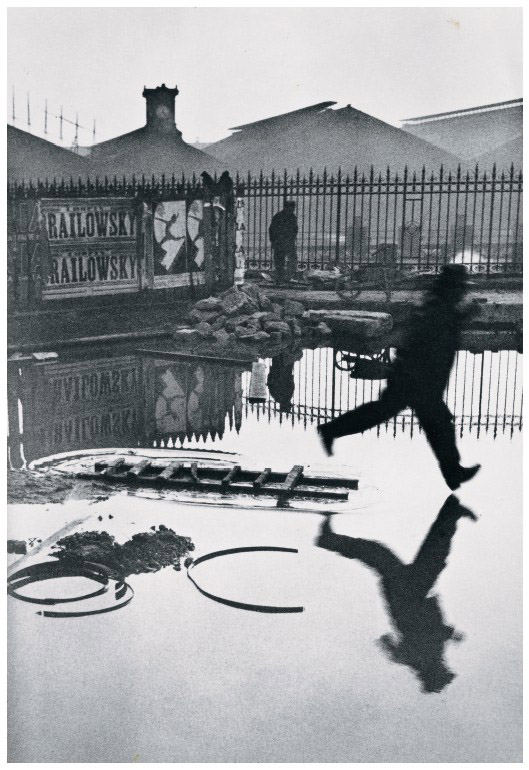A Retrospective of Henri Cartier-Bresson
Under the leadership of the director of the foundation, Roberta Delpirea, the main part of the celebration took place: a comprehensive retrospective in the new building of the Bibliothèque Nationale de France, and the publication of a 432-page monograph. Apart from the primary curator and author of the installation, other luminaries contributed essays in the book, such as Jean-Noël Jeanneney, Peter Galassi, Jean Clair, Jean Leymarie, Serge Toubiana, Philippe Arbaïzar, Claude Cookman. The book has an exhaustive bibliography.
Naturally one need not introduce the legend of HCB to the subscribers of
Fotograf. The style of his photographs capturing the atmosphere exposed in
the canon of a decisive moment, and his prints of the full format of the frame inspired countless followers. However, the 476 reproductions in the photography section of his legacy (and in fact even the 36 illustrations in the complementary drawing and painting section) diminish the overall effect. Henri Cartier-Bresson did not achieve as many visual miracles – that, in any case, is not humanly possible.
In principle, one cannot object against including drawings or even two early
paintings. They demonstrate how Cartier-Bresson’s vision drew on his keen
artistic sensibility and his yearning for harmony. The paintings are not, however, presented as a documentation of the sources of his genius, but rather as an integral part of his work. It is true that in the last twenty-five years of his life, Cartier-Bresson preferred drawing to photography. Even though the book features a photograph from the late 1990s, it is rather as an exception to the rule. Cartier-Bresson’s opinion that that at seventy years of age, it is hard to continue in the career of a street photographer is sensible enough. His drawings, however, are not as penetrating as his best photographs. Henri Cartier-Bresson’s statement that “photography is immediate action, drawing is meditation”, which Jean Leymarie, the former director of the French Academy in Rome, used as a motto for his article, is a bon mot rather than a statement one could draw serious conclusions from.
Evidently there was no intention to organize the photographs chronologically. This could have served as a suitable strategy, had it not been accompanied by inconsistencies in the organization of theme units, since these on the other hand have an Aristotelian unity of place and history. If the link between territory and chronology is repeatedly broken, the overall effect is chaotic. If only the very best photographs were presented out of historical context, the result would not be so disruptive, since they could be perceived separately. Unfortunately, the context of style as well as subject matter is ignored with little positive effect: a double page
presents three shots of the Berlin wall (1962) next to a shot taken on a Romanian train (1975)… the series of China in the late 1940s stretches over thirty-two pages, only to be – without any kind of transition – concluded by two pages devoted to photographs from Japan (1965); and the Chinese photographs are themselves preceded by a full-page reproduction of a photograph from Italy (1933).
An idea that may find its fans among readers is that among the black and
white reproductions of the works themselves are included reproductions of the colorful covers of various publications devoted to HCB, including the cover of the very first monograph devoted to Henri Cartier-Bresson, edited by Anna Fárová and published in 1958 in Prague. This element might have also become a graphic guide to the various periods of a long career, a kind of indicator of the historical change of mood. But here it is again: why does the cover of Les Européens (1955) appear next to a picture from Mexico (1934)?
The chaotic concept of the visual composition of the book is totally alien to
the foreign publications we have become used to, customarily based on a
faultless composition. It is a truly paradoxical reading of the title De qui s’agitil?
Henri Cartier-Bresson.
#3 Transforming of Symbols
Archive
- #45 hypertension
- #44 empathy
- #43 collecting
- #42 food
- #41 postdigital photography
- #40 earthlings
- #39 delight, pain
- #38 death, when you think about it
- #37 uneven ground
- #36 new utopias
- #35 living with humans
- #34 archaeology of euphoria
- #33 investigation
- #32 Non-work
- #31 Body
- #30 Eye In The Sky
- #29 Contemplation
- #28 Cultura / Natura
- #27 Cars
- #26 Documentary Strategies
- #25 Popular Music
- #24 Seeing Is Believing
- #23 Artificial Worlds
- #22 Image and Text
- #21 On Photography
- #20 Public Art
- #19 Film
- #18 80'
- #17 Amateur Photography
- #16 Photography and Painting
- #15 Prague
- #14 Commerce
- #13 Family
- #12 Reconstruction
- #11 Performance
- #10 Eroticon
- #9 Architecture
- #8 Landscape
- #7 New Staged Photography
- #6 The Recycle Image
- #5 Borders Of Documentary
- #4 Intimacy
- #3 Transforming Of Symbol
- #2 Collective Authorship
- #1 Face


